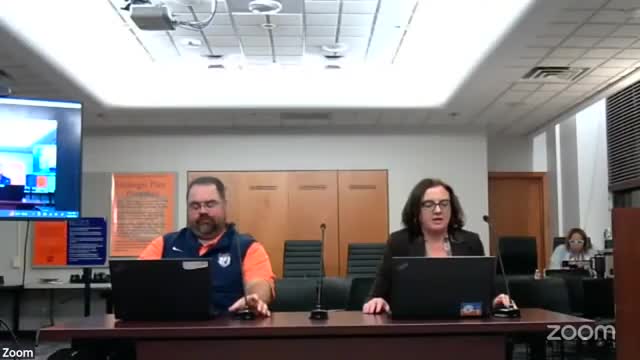District insurance committee recommends benefit changes including Rx savings card for GLP‑1 medications; nets an 8% renewal
October 10, 2025 | Oak Park - River Forest SD 200, School Boards, Illinois
This article was created by AI summarizing key points discussed. AI makes mistakes, so for full details and context, please refer to the video of the full meeting. Please report any errors so we can fix them. Report an error »

The district’s insurance committee presented its annual insurance renewal analysis and a proposed plan design that would limit budgetary impact while continuing coverage for GLP‑1 weight‑loss medications under a new approach.
The presenter (identified in the discussion as a benefits/insurance committee representative) said an initial actuarial projection called for a 14% increase to the district’s self‑insured plan because of rapidly rising pharmacy claims, then negotiations lowered the projection to about 17% before the committee identified savings. After combining a proposed Rx savings card for certain manufacturer drugs with modest plan design changes, the committee presented a renewal that staff said aligns with the board‑approved budget increase of roughly 8%.
Key points
- GLP‑1 medications and Rx savings card: Committee members described a rapidly rising trend in GLP‑1 prescriptions and proposed an Rx savings card that would let employees access manufacturer pricing (presenters said the manufacturer program would reduce employer cost by roughly two thirds for covered drugs). Under the proposal, employees who elect the Rx savings option would be required to participate in a district‑sponsored weight‑management program that includes coaching and periodic check‑ins. The committee proposed splitting an illustrative $500 per‑month cash price roughly 50/50 between employer and employee (presenters said the district historically paid a higher cost when the drugs were covered under the medical plan).
- Cost and participation: Presenters said about 72 insured employees (about 20% of the insured population) were currently taking GLP‑1 drugs; that number has increased over the prior year. The committee cautioned that growth remains uncertain but said the Rx savings card plus program participation would mitigate plan exposure and keep the renewal within the budgeted 8% increase.
- Other plan choices: Committee members evaluated stop‑loss (reinsurance) attachment levels and other plan design levers but said changes to stop‑loss terms this year were likely to raise fixed costs and thus had limited near‑term yield. The committee also described multi‑year cost‑saving strategies that have reduced claims exposure over prior renewals.
Board discussion and next steps
Board members pressed for clarity about employee out‑of‑pocket impacts, comparisons with peer districts and whether alternative stop‑loss levels were worth re‑pricing. Administrators said they would continue to pursue underwriting quotes and return to the board if a materially better stop‑loss option emerged. Presenters framed the current proposal as within the approved budget and subject to continued monitoring.
Ending: Administrators said the committee believes the combined package of Rx savings, program participation and modest plan design updates balances fiscal responsibility with benefit access and will return with any further underwriting options if they become cost‑effective.
The presenter (identified in the discussion as a benefits/insurance committee representative) said an initial actuarial projection called for a 14% increase to the district’s self‑insured plan because of rapidly rising pharmacy claims, then negotiations lowered the projection to about 17% before the committee identified savings. After combining a proposed Rx savings card for certain manufacturer drugs with modest plan design changes, the committee presented a renewal that staff said aligns with the board‑approved budget increase of roughly 8%.
Key points
- GLP‑1 medications and Rx savings card: Committee members described a rapidly rising trend in GLP‑1 prescriptions and proposed an Rx savings card that would let employees access manufacturer pricing (presenters said the manufacturer program would reduce employer cost by roughly two thirds for covered drugs). Under the proposal, employees who elect the Rx savings option would be required to participate in a district‑sponsored weight‑management program that includes coaching and periodic check‑ins. The committee proposed splitting an illustrative $500 per‑month cash price roughly 50/50 between employer and employee (presenters said the district historically paid a higher cost when the drugs were covered under the medical plan).
- Cost and participation: Presenters said about 72 insured employees (about 20% of the insured population) were currently taking GLP‑1 drugs; that number has increased over the prior year. The committee cautioned that growth remains uncertain but said the Rx savings card plus program participation would mitigate plan exposure and keep the renewal within the budgeted 8% increase.
- Other plan choices: Committee members evaluated stop‑loss (reinsurance) attachment levels and other plan design levers but said changes to stop‑loss terms this year were likely to raise fixed costs and thus had limited near‑term yield. The committee also described multi‑year cost‑saving strategies that have reduced claims exposure over prior renewals.
Board discussion and next steps
Board members pressed for clarity about employee out‑of‑pocket impacts, comparisons with peer districts and whether alternative stop‑loss levels were worth re‑pricing. Administrators said they would continue to pursue underwriting quotes and return to the board if a materially better stop‑loss option emerged. Presenters framed the current proposal as within the approved budget and subject to continued monitoring.
Ending: Administrators said the committee believes the combined package of Rx savings, program participation and modest plan design updates balances fiscal responsibility with benefit access and will return with any further underwriting options if they become cost‑effective.
View full meeting
This article is based on a recent meeting—watch the full video and explore the complete transcript for deeper insights into the discussion.
View full meeting
